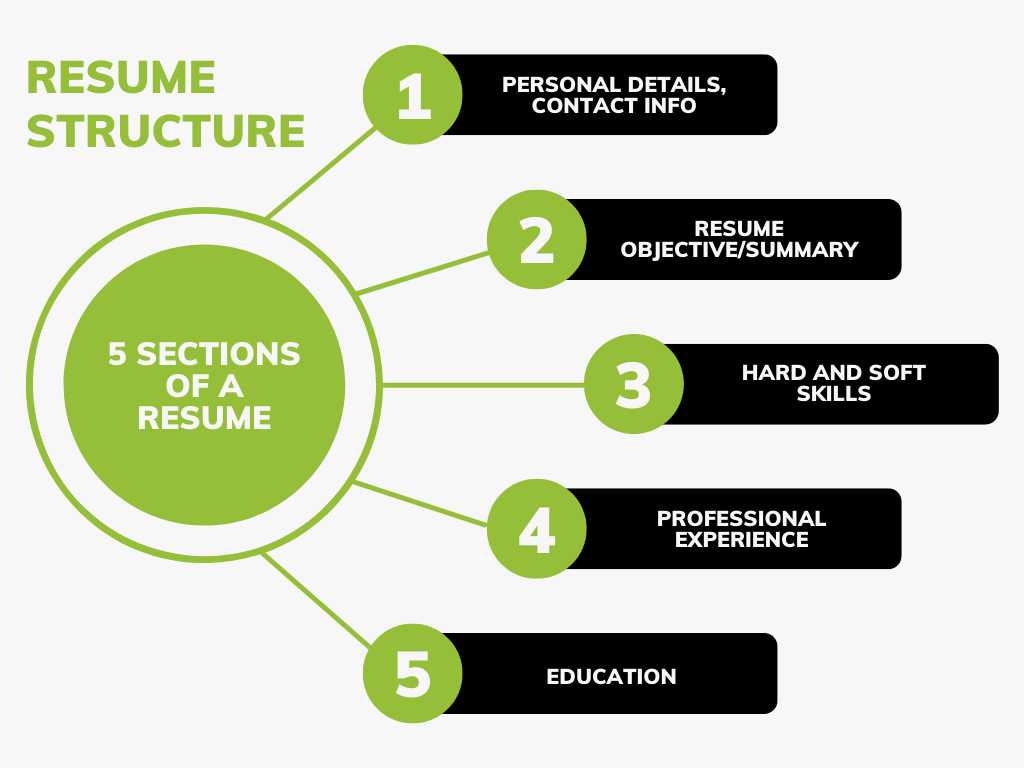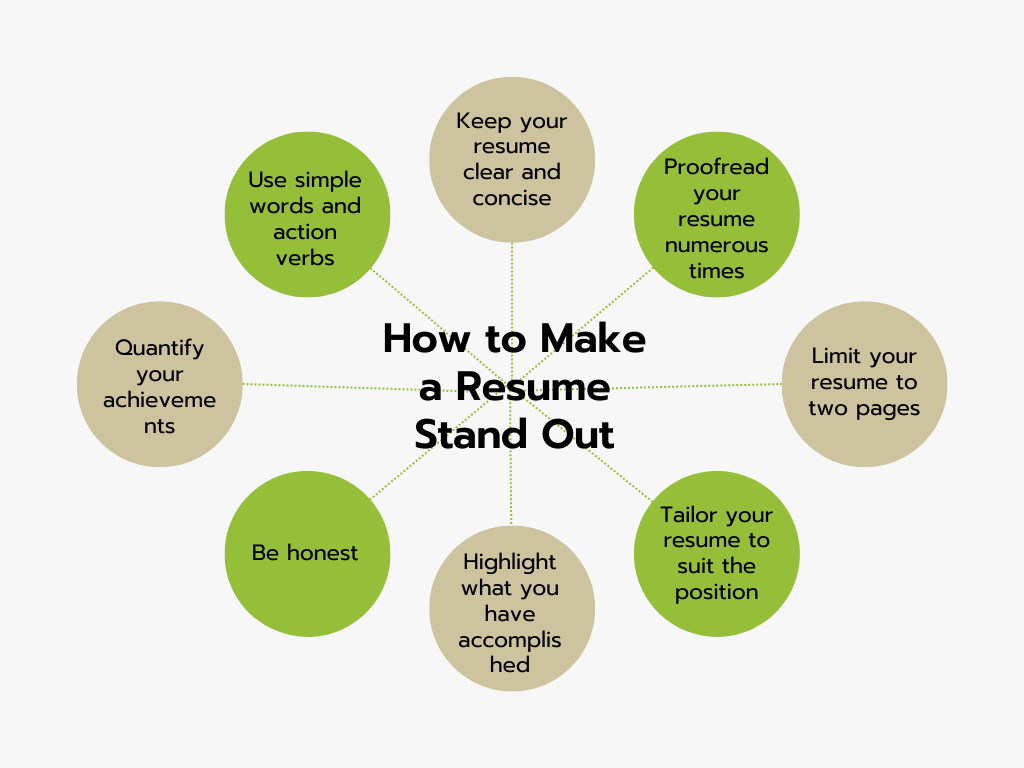Whether you are fresh out of college or joining the job hunt after a while, an outstanding resume is your only chance to get the foot in the door. It’s a one-page elevator pitch that can make or break your career. HR manager spares less than 10 seconds to browse your resume and discard it. To avoid the rejection pile, learn the resume tips and tricks of grabbing the recruiters’ attention and making them call you for an interview. We know them because we’ve been in this business for years and know how to write a resume for a job and translate it into HR-speak. Let’s take it one step at a time.

Resume objective is like a book or an article abstract. It provides recruiters with crucial information at a glance. Therefore, it must answer two questions:
List and detail all your past gigs and pick only those that apply to the position you wish to occupy. Reverse chronological order means that your work history should go from the latest job to the earliest. Each point should recount:
How to Make a Resume Stand out
Don’t take a sigh of relief after you’ve written the content. Now it’s time to make your resume look good on paper and on screen. There are five aspects to consider when formatting the document:
However, if your skills and expertise don’t fit onto a single page, add a second one. Do not squeeze everything on one page by eliminating the margins or using the font size below 10pt. Your application will seem overcrowded and unprofessional like you couldn’t cut the redundant data and were too insecure to add another page.
However, do not go overboard with dividers. If you format the resume like a list, lines after each point will make the document look like a set of unrelated data. As a result, lines will have an opposite effect and ruin readability.
Add your headshot if you have free space or if the job listing calls for it. The photo should be relevant and make you look professional. If you don’t have a suitable photo, have a photographer take it. Use this shot in all your professional accounts, including LinkedIn.
Small icons are also appropriate at subsection names or contacts. They break up the wall of text and make the resume stand out. Use them sparingly, and they will work to your advantage.
With years of HR experience, our cheap resume writing services and editors speak the language of recruiters and know exactly how to pitch you to secure an interview, a callback, and a dream job. In just a day or two, you will get your picture-perfect resume ready to circulate among would be employers. Your career success is one resume away!
Suggested Reading:

How to Write an Objective for a Resume
The objective is among the critical parts of the application that doesn’t get enough attention and effort from applicants. Most don’t know how to write an objective for a resume and only add the desired job title. However, it can be so much more.Resume objective is like a book or an article abstract. It provides recruiters with crucial information at a glance. Therefore, it must answer two questions:
- What position do you hope to get?
- What makes you the most suitable candidate for the role?
How to Recount Relevant Experience and Education
Unless you are fresh out of college, education shouldn’t be the focus of your application. Keep the record short with basic information, such as school name, location, degree, and GPA, if it’s 3.0 or higher.List and detail all your past gigs and pick only those that apply to the position you wish to occupy. Reverse chronological order means that your work history should go from the latest job to the earliest. Each point should recount:
- Company name, industry, city;
- Dates of your employment;
- Position held;
- Details or esponsibilities.
- Coordinated a team of five software engineers in a year-long web development project that concluded on time and on budget.
- Spearheaded the shift towards a proprietary task-management platform that improved company efficiency by 7%.
- Developed the Facebook content strategy that increased the audience by 2,000 followers in one month.
How to Select Skill for Resume
Hard skills are the backbone of your job application. These are quantifiable professional skills you’ve gained in college or developed when holding your prior positions. These include:- Foreign language proficiency;
- Software skills;
- Social media marketing;
- Editing and proofreading;
- Programming skills;
- Bookkeeping experience;
- Data visualization, and more.
- Time-management;
- Leadership;
- Conflict management;
- Adaptability;
- Self-motivation;
- Critical thinking;
- Public speaking;
- Lateral thinking.
What Additional Information to Include
The padded additional data section can make up for the lack of relevant experience. Moreover, it provides HR managers with a glance at your best side even if you do not attach a cover letter. Besides, you don’t have to brag, just recount your most significant accomplishments. Most applicants specify:- Publications. These might not be relevant for every application but will prove your scientific experience and academic writing prowess. You can also include the papers that are awaiting publication in peer-reviewed journals, as they might take over a year from submission to print.
- Certificates. Similar to work experience, your extracurricular activities should be relevant. However, you can write about the accomplishments that make you proud, they might impress recruiters into giving you a chance. For instance, Mayim Bialik included her neurobiology Ph.D., and it was among the factors that got her a role on The Big Bang Theory.
- Awards and honors. If you have little working for your resume, this section might be your saving grace. Add the competitions, scholarships, and contests you’ve won. You should also specify them if you were a runner-up or a finalist.
How to Make a Resume Stand out

Don’t take a sigh of relief after you’ve written the content. Now it’s time to make your resume look good on paper and on screen. There are five aspects to consider when formatting the document: Length
How long should a resume be? Most recruiters recommend limiting the file to a single page. It’s an industry-standard format.However, if your skills and expertise don’t fit onto a single page, add a second one. Do not squeeze everything on one page by eliminating the margins or using the font size below 10pt. Your application will seem overcrowded and unprofessional like you couldn’t cut the redundant data and were too insecure to add another page.
Margins
One-inch margins are the safest bet. They make any document look neat and streamlined. However, you can decrease the margin size if you need to put a couple of additional lines to your resume without adding an extra page. Do not use margins below half an inch. Your document will look cramped, making it a turnoff for recruiters.Font
Serif fonts are best for printed documents, while Sans-serif typefaces are well-suited for digital content, as they are easier on the eyes.- Choose the font that looks professional and avoid weird fonts, like Comic Sans or Pinyon Script. Times New Roman, Helvetica, Arial, and Georgia are all safe bets.
- Stick with the same typeface throughout the document, but play around with sizes. Your name should use the largest font (24pt), the body of the document can be 14pt or 12pt, and bullet lists should be a size smaller (12pt or 10pt).
- Make resume readability a priority. HR managers should not need to reach for glasses to make out your skills, so let 10pt be the smallest font size you use for both paper and digital versions of the resume.
Lines
Lines are great to separate subsections of the document and improve readability. Use page breakers after resume objective and further on to divide the document into logical blocks. Depending on how many columns you use, you can use horizontal and vertical lines.However, do not go overboard with dividers. If you format the resume like a list, lines after each point will make the document look like a set of unrelated data. As a result, lines will have an opposite effect and ruin readability.
Visual Aid
Add color to your application, but keep the hues reasonable and professional. A splash of color is acceptable, but the whole palette will draw the attention away from the content. If you don’t know how to make a resume a bit more colorful, browse resume templates available online. Use the one you like or the one that resembles the color scheme of the company that you are reaching out to. The latter approach will demonstrate you’ve done your homework and might earn you extra points with the recruiters.Add your headshot if you have free space or if the job listing calls for it. The photo should be relevant and make you look professional. If you don’t have a suitable photo, have a photographer take it. Use this shot in all your professional accounts, including LinkedIn.
Small icons are also appropriate at subsection names or contacts. They break up the wall of text and make the resume stand out. Use them sparingly, and they will work to your advantage.
What to Do After the Resume is Done
However great your application looks at this point, your ultimate goal is to sell yourself to would be employers. To achieve this goal, there are a few more steps for you to take:- Proofread. Hire a professional proofreader or get your loved ones with grammar nazi tendencies to check your spelling. You don’t want to send out dozens of copies with a typo in your name, email or phone number.
- Save. Save the text file under “My Perfect Resume” or just “First Name Last Name” to the hard drive and convert it to PDF and other commonly used formats to ensure formatting stays consistent. Upload an editable copy of the file to the cloud. This way you won’t have to start from scratch even if your computer crashes.
- Print. You will likely email the resume, but it never hurts to have a few printed copies on hand to take along to interviews and spread among your network. You never know which copy will get you the job.
How to Write a Resume for a Job Like a Pro
They say it takes 10,000 hours of practice to master a skill. However, you don’t have months and years to gain top-level resume writing prowess. You want the job now. With funds running out, you are working against the clock. To get the desired results fast, order a professional resume from us!With years of HR experience, our cheap resume writing services and editors speak the language of recruiters and know exactly how to pitch you to secure an interview, a callback, and a dream job. In just a day or two, you will get your picture-perfect resume ready to circulate among would be employers. Your career success is one resume away!
Suggested Reading:
- Resume Writing Mistakes That Ruin Your Job Applications
- Resume Format Guide


